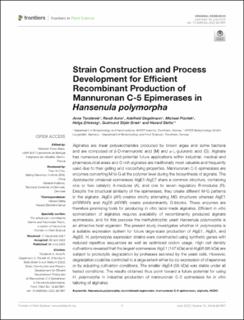| dc.contributor.author | Tøndervik, Anne | |
| dc.contributor.author | Aune, Randi | |
| dc.contributor.author | Degelmann, Adelheid | |
| dc.contributor.author | Piontek, Michael | |
| dc.contributor.author | Ertesvåg, Helga | |
| dc.contributor.author | Skjåk-Bræk, Gudmund | |
| dc.contributor.author | Sletta, Håvard | |
| dc.date.accessioned | 2022-10-26T12:27:33Z | |
| dc.date.available | 2022-10-26T12:27:33Z | |
| dc.date.created | 2022-09-26T12:21:10Z | |
| dc.date.issued | 2022 | |
| dc.identifier.citation | Frontiers in Plant Science. 2022, 13 1-10. | en_US |
| dc.identifier.issn | 1664-462X | |
| dc.identifier.uri | https://hdl.handle.net/11250/3028446 | |
| dc.description.abstract | Alginates are linear polysaccharides produced by brown algae and some bacteria and are composed of β-D-mannuronic acid (M) and α-L-guluronic acid (G). Alginate has numerous present and potential future applications within industrial, medical and pharmaceutical areas and G rich alginates are traditionally most valuable and frequently used due to their gelling and viscosifying properties. Mannuronan C-5 epimerases are enzymes converting M to G at the polymer level during the biosynthesis of alginate. The Azotobacter vinelandii epimerases AlgE1-AlgE7 share a common structure, containing one or two catalytic A-modules (A), and one to seven regulatory R-modules (R). Despite the structural similarity of the epimerases, they create different M-G patterns in the alginate; AlgE4 (AR) creates strictly alternating MG structures whereas AlgE1 (ARRRAR) and AlgE6 (ARRR) create predominantly G-blocks. These enzymes are therefore promising tools for producing in vitro tailor-made alginates. Efficient in vitro epimerization of alginates requires availability of recombinantly produced alginate epimerases, and for this purpose the methylotrophic yeast Hansenula polymorpha is an attractive host organism. The present study investigates whether H. polymorpha is a suitable expression system for future large-scale production of AlgE1, AlgE4, and AlgE6. H. polymorpha expression strains were constructed using synthetic genes with reduced repetitive sequences as well as optimized codon usage. High cell density cultivations revealed that the largest epimerases AlgE1 (147 kDa) and AlgE6 (90 kDa) are subject to proteolytic degradation by proteases secreted by the yeast cells. However, degradation could be controlled to a large extent either by co-expression of chaperones or by adjusting cultivation conditions. The smaller AlgE4 (58 kDa) was stable under all tested conditions. The results obtained thus point toward a future potential for using H. polymorpha in industrial production of mannuronan C-5 epimerases for in vitro tailoring of alginates. | en_US |
| dc.language.iso | eng | en_US |
| dc.publisher | Frontiers | en_US |
| dc.rights | Navngivelse 4.0 Internasjonal | * |
| dc.rights.uri | http://creativecommons.org/licenses/by/4.0/deed.no | * |
| dc.subject | HCDC | en_US |
| dc.subject | alginate | en_US |
| dc.subject | mannuronan C-5 epimerases | en_US |
| dc.subject | recombinant expression | en_US |
| dc.subject | Hansenula polymorpha | en_US |
| dc.title | Strain Construction and Process Development for Efficient Recombinant Production of Mannuronan C-5 Epimerases in Hansenula polymorpha | en_US |
| dc.title.alternative | Strain Construction and Process Development for Efficient Recombinant Production of Mannuronan C-5 Epimerases in Hansenula polymorpha | en_US |
| dc.type | Peer reviewed | en_US |
| dc.type | Journal article | en_US |
| dc.description.version | publishedVersion | en_US |
| dc.rights.holder | Copyright © 2022 Tøndervik, Aune, Degelmann, Piontek, Ertesvåg, Skjåk-Bræk and Sletta. | en_US |
| dc.source.pagenumber | 1-10 | en_US |
| dc.source.volume | 13 | en_US |
| dc.source.journal | Frontiers in Plant Science | en_US |
| dc.identifier.doi | 10.3389/fpls.2022.837891 | |
| dc.identifier.cristin | 2055410 | |
| cristin.ispublished | true | |
| cristin.fulltext | original | |
| cristin.qualitycode | 2 | |

